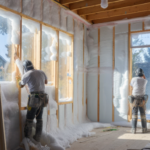
Boost Energy Efficiency with Insulation Removal for Buildings

Winter Roof Maintenance Tips for Longevity
Whether you’re a commercial property manager overseeing a large facility or a homeowner upgrading your residence, planning and budgeting are essential for a successful new roof construction project. The process may seem daunting, but with the right steps, you can ensure a durable, aesthetically pleasing roof that fits your financial plan.
Here’s a guide to help you navigate the key aspects of planning and budgeting for your new roof.
1. Assess Your Needs
Before diving into the planning process, evaluate your property’s specific requirements. Consider:
- Type of Property: Residential and commercial roofs have distinct needs. Commercial roofs often require flat or low-slope designs, while residential roofs may involve pitched or shingled styles.
- Material Preferences: Common materials include asphalt shingles, metal, tile, or TPO for flat roofs. Each material has different costs, lifespans, and maintenance requirements.
- Long-Term Goals: Are you looking for energy efficiency, durability, or aesthetic appeal? Defining your priorities helps narrow your options.
2. Research Roofing Options
The type of roof you choose will significantly impact the overall cost and performance. Key considerations include:
- Cost Per Square Foot: Materials like asphalt shingles are cost-effective, while metal and tile are more expensive but longer-lasting.
- Climate Suitability: Select materials that withstand local weather conditions, such as high heat, heavy rainfall, or snow.
- Energy Efficiency: Options like reflective coatings or cool roofs can reduce energy bills over time.
3. Establish a Realistic Budget
A well-thought-out budget ensures your roofing project stays on track without unexpected expenses. Factors to include in your budget are:
- Materials: Choose a material that balances cost, durability, and aesthetics.
- Labor Costs: Professional installation is crucial for a long-lasting roof. Labor costs can vary depending on the complexity of the project.
- Permits and Inspections: Many municipalities require permits for roof construction. Ensure these costs are accounted for.
- Contingency Fund: Set aside 10-15% of your budget for unexpected expenses, such as hidden damage or unforeseen delays.
4. Partner with a Trusted Roofing Contractor
Choosing the right contractor is one of the most critical steps in ensuring your project’s success. Look for:
- Experience and Expertise: Work with a company experienced in both residential and commercial roofing.
- Transparent Pricing: Avoid surprises by requesting detailed estimates and contracts.
- Reputation: Check reviews, testimonials, and accreditations, such as a Better Business Bureau rating, to verify the contractor’s credibility.
5. Plan for Maintenance and Upkeep
A new roof is an investment that requires ongoing care. Include future maintenance costs in your budget to extend the roof’s lifespan and maximize its value.
Contact Rain Man Roofing Today!
At Rain Man Roofing, we specialize in providing high-quality roofing solutions for both residential and commercial properties. With over 25 years of experience and a commitment to customer satisfaction, we ensure every project is completed on time, within budget, and to the highest standards.
Contact Rain Man Roofing today for a consultation and personalized estimate for your roofing needs. Visit Rain Man Roofing or call us now to get started on your successful new roof construction project!


